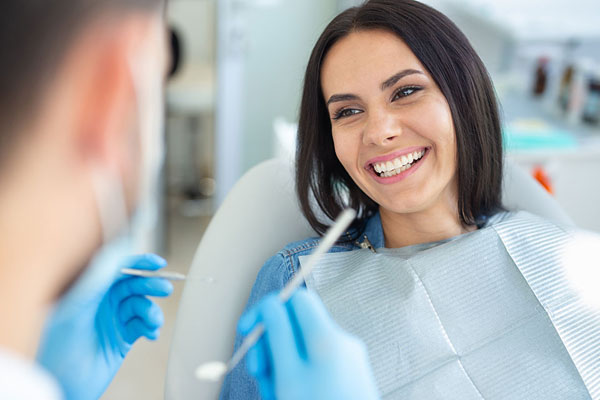Pulp Capping Treatment in Los Angeles & Studio City
Pulp Capping: A Gentle Alternative to Root Canals
If you have a damaged or infected tooth, your dentist may recommend pulp capping as a treatment option. Depending on your oral health condition, our dentist may decide pulp capping is more beneficial for your health than root canal therapy if your tooth pulp is exposed but not yet infected.
Learn more about this root canal alternative and minimally invasive solution by calling our Los Angeles & Studio City dentist at (213) 623-2212.
What is Pulp Capping?
Pulp capping is a dental procedure designed to save a damaged or infected tooth by protecting and potentially regenerating the tooth’s pulp. The pulp is the soft tissue inside the tooth containing nerves, blood vessels, and connective tissue. When exposed or infected, it can lead to severe tooth pain and potential tooth loss.
Pulp capping involves placing a protective material over the exposed or nearly exposed pulp. This material helps to prevent bacteria from entering the pulp, reducing inflammation and encouraging the pulp to heal.
Benefits of Pulp Capping
Pulp capping offers several advantages over more invasive treatments like root canals or extractions:
Preservation of the natural tooth: Pulp capping aims to save the entire tooth, including its nerve and blood supply.
- Pain relief: By addressing the underlying issue, pulp capping can effectively alleviate tooth pain.
- Faster recovery: Compared to root canals, pulp capping often involves less treatment time and quicker healing.
- Cost-effective: Pulp capping is generally more affordable than root canal therapy.
- Improved long-term oral health: Saving the natural tooth can contribute to overall oral health and function.
Qualifications for Pulp Capping
Not every tooth is a suitable candidate for pulp capping. Several factors determine eligibility:
- Extent of damage: The damage to the pulp must be minimal. Larger exposures or severe infections may require a root canal.
- Patient’s overall oral health: Good oral hygiene is essential for successful pulp capping.
- Tooth location: Pulp capping is generally more successful on back teeth than on front teeth.
- Patient’s symptoms: The absence of severe pain or swelling is often a positive indicator.
Your dentist will conduct a thorough examination to determine if pulp capping is the right treatment option for you.
How Does Pulp Capping Work?
Pulp capping is typically performed in two different ways: direct pulp capping and indirect pulp capping.
Direct Pulp Capping
The direct pulp capping procedure involves applying a medicated material directly to the exposed pulp of a tooth. This procedure is typically performed when a small area of the pulp has been exposed due to a cavity or other damage.

The direct pulp capping procedure involves:
- Removing Tooth Decay: Your endodontist will start by drilling the cavity and removing any decayed tooth material. They’ll thoroughly clean the area.
- Adding Sedative Material: After the decay is removed, they’ll use a sedative material to protect the tooth pulp from bacteria until the dentin can repair itself.
- Filling the Cavity: A temporary or permanent dental filling is placed to strengthen the tooth and allow the patient to bite and chew easily.
Indirect Pulp Capping
The indirect pulp capping procedure is typically performed when a larger area of the pulp has been exposed due to significant decay or damage. This procedure involves removing as much decayed or damaged tissue as possible and applying a medicated material to the remaining pulp.
The medicated material used in indirect pulp capping encourages the growth of new dentin, a substance that helps protect the pulp. Your dentist will place a temporary filling over the tooth to protect it while the dentin grows.
The indirect pulp capping procedure typically involves:
- Removing Decay: The endodontist will start by removing decayed tooth material but will leave a small portion to cover the pulp tissue.
- Adding Sedative Material: Just like direct pulp capping, a protective sedative material is applied to the decayed dentin.
- Filling the Cavity: Then, the dental professional will place the temporary filling until you come back for your second appointment.
- Evaluating Progress: After about six to eight months, your endodontist will remove the temporary filling to evaluate the status of your recovery. In most cases, the previously decayed dentin has regenerated, and any residual decay is removed.
- Getting the Permanent Restoration: Lastly, a permanent dental filling is placed to strengthen the tooth and allow the patient to eat, bite, and speak normally.
Materials Used in Pulp Capping
There are several materials available for pulp capping, including:
- Calcium Hydroxide: Traditionally, this has been the most commonly used pulp capping material. It promotes the formation of reparative dentin.
- Mineral Trioxide Aggregate (MTA): This is currently the gold standard for pulp capping because it provides a good seal, has high biocompatibility, and promotes dentin regeneration.
- Bioactive Cement: These include materials like Biodentine which are easy to use, biocompatible, and also promote dentin regeneration.
 Pulp Capping Aftercare
Pulp Capping Aftercare
Proper aftercare is crucial for the success of a pulp capping procedure. By following these guidelines, you can optimize your healing process and reduce the risk of complications.
- Pain management: While discomfort is minimal, you may experience some sensitivity or mild pain. Over-the-counter pain relievers can help manage any discomfort.
- Avoid biting on the treated tooth: To prevent damage to the treated area, avoid chewing on the tooth for at least 24 hours.
- Oral hygiene: Maintain good oral hygiene by brushing and flossing gently, but avoid the treated area.
- Regular check-ups: Schedule follow-up appointments with your dentist to monitor the tooth’s healing process.
- Avoid hard and chewy foods: For the first few days, stick to soft foods to prevent excessive pressure on the treated tooth.
- Watch for signs of infection: If you experience severe pain, swelling, or other unusual symptoms, contact your dentist immediately.
Frequently Asked Questions
Pulp capping is generally not painful, as local anesthetic numbs the area around the tooth being treated. Patients may experience mild discomfort or sensitivity after the procedure, which can be managed with over-the-counter pain medication.
After pulp capping, avoid eating or drinking anything for at least one hour to allow the anesthesia to wear off. After this time, patients can typically resume their diet, although they should avoid hard, crunchy, or sticky foods that could damage the treated tooth.
The procedure can be completed in a single visit to the dentist and usually takes 30 to 60 minutes. The length of time required for pulp capping can vary depending on the extent of the damage and the number of teeth being treated.
Whether or not insurance covers pulp capping depends on the individual policy and the specific circumstances of the patient’s case. Some insurance policies may cover the cost of pulp capping if deemed medically necessary, while others may not cover the procedure at all. Check with your insurance provider to determine your coverage options.
Discover an Easier Way to Treat Infected Teeth
Pulp capping can be an effective treatment option for patients with minor damage or infection in the pulp tissue. By promoting healing and regeneration of the pulp tissue, pulp capping can help preserve the natural tooth and prevent the need for more invasive treatments like root canal therapy or tooth extraction.
Contact our dentist in Los Angeles & Studio City at (213) 623-2212 to learn more. We also welcome patients from North Hollywood, Orange County, and Hollywood Hills, CA.

 Preservation of the natural tooth:
Preservation of the natural tooth: Pulp Capping Aftercare
Pulp Capping Aftercare
